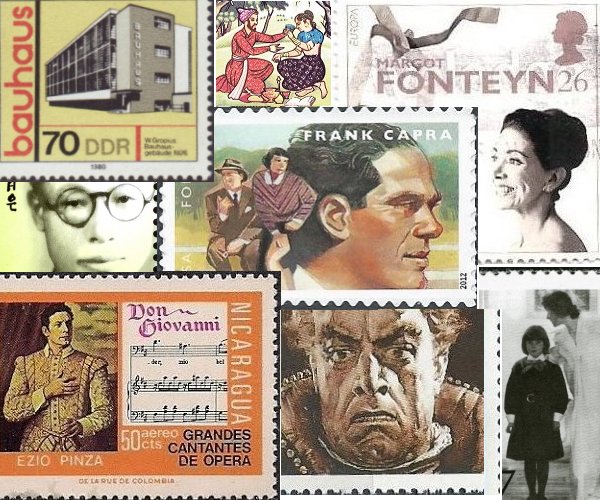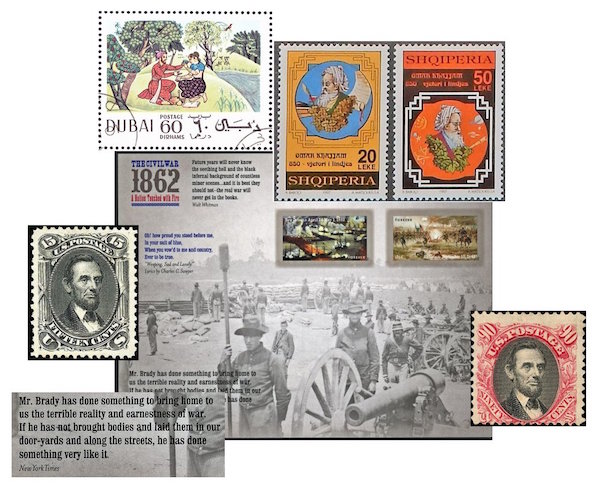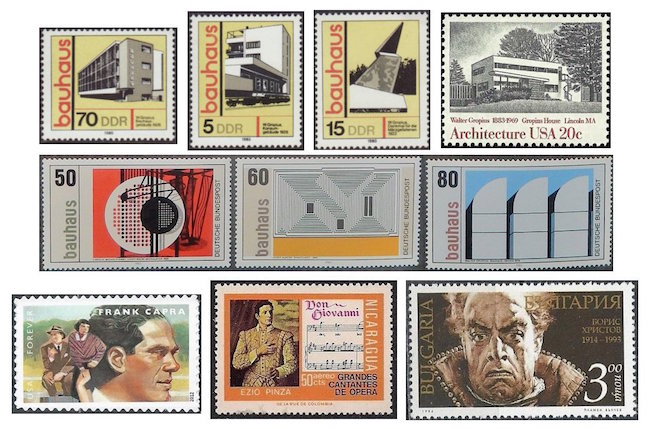The Arts on the Stamps of the World — May 18
An Arts Fuse regular feature: the arts on stamps of the world.

By Doug Briscoe
May 18th’s headliners are Omar Khayyám, Civil War photographer Mathew Brady, Walter Gropius, Frank Capra, Margot Fonteyn, and operatic basses Ezio Pinza and Boris Christoff. We also offer birthday greetings to composers Karl Goldmark and Meredith Willson, photographer Gertrude Käsebier, and more.
18 May is the birthday of the great Persian poet Omar Khayyám (1048 – 4 December 1131), author of the beloved Rubáiyát. His full name at birth was—ready?—Ghiyath ad-Din Abu’l-Fath ‘Umar ibn Ibrahim al-Khayyam Nishapuri. An extraordinary polymath, Khayyám was also a mathematician, astronomer, and philosopher. But his poetry, known in the West through the translations of Edward FitzGerald (1809–83), is what endears him to many hearts. “A Jug of Wine, a Loaf of Bread—and Thou / Beside me singing in the Wilderness” has been captured on a stamp from Dubai, and the poet has also been honored on a pair of stamps from Albania (Shqiperia). I suspect an Iranian stamp must exist, but I can’t find it. Western classical music is indebted to the master for a number of lovely scores. American composer Arthur Foote wrote an orchestral suite called “Four Character Pieces after the Rubáiyát of Omar Khayyám” in 1900. Englishman Granville Bantock completed a large choral/orchestral work with solo voices in 1909. Later settings have been made by Hindemith, Roger Quilter, Boris Blacher, Harrison Kerr, and Emma Lou Diemer, whose choral work “Verses from the Rubáiyát” dates from 1967. Further choral settings have been made by Thomas Adès and Martin Amlin, whose lovely string-accompanied “Time’s Caravan” (1988) has been recorded on Koch by the John Oliver Chorale. One of the last works by the late Einojuhani Rautavaara was a song cycle for baritone and piano, “Rubaiyat” (2014). My favorite composition by American composer Alan Hovhaness is his haunting “Rubáiyát of Omar Khayyám” (1975), scored for solo accordion (beautifully and sensitively treated) and orchestra with narration. A recording under André Kostelanetz features exquisite readings by Douglas Fairbanks, Jr. There is also a fine later recording with Michael York.
The United States has not yet directly honored Mathew B. Brady (May 18, 1822 – January 15, 1896) with a stamp, but his work appears on some of the oldest and newest issues in American postal history. Recently, to commemorate the sesquicentennial of the Civil War, sheets were issued one each year from 2011 to 2015. From that series I chose the 1862/2012 sheet, which offers a quotation about Brady (magnified at lower left). The Lincoln stamps that are superimposed on the sheet were based on a Brady photograph of the president; the fifteen-cent gray stamp was the very first one to be issued in Lincoln’s honor (1866), and the two-toned 90-cent stamp came out three years later. Brady studied with Samuel F. B. Morse, who introduced daguerreotypes to America, and opened his own New York studio in 1844. Among the other dignitaries he photographed were Andrew Jackson, John Quincy Adams, Daniel Webster, and Edgar Allan Poe. Brady created over 10,000 plates during the war, using his own money in hopes that the U.S. Government would buy them all, but fiscal conservatives demurred, and Brady had to sell his studio and declare bankruptcy. Congress did later grant Brady $25,000, but it wasn’t nearly enough to get him out of debt, and after being injured in a streetcar accident, he died a pauper in a charity ward.

Today is also the birthday of Bauhaus founder Walter Gropius (1883 – 5 July 1969). As a young man Gropius worked in the firm of Peter Behrens along with Mies van der Rohe and Le Corbusier, thereafter founding his own company with Adolf Meyer in Berlin in 1910. Their collaboration resulted in the facade for the Faguswerk, one of the breakthroughs in modernist architecture. Gropius was drafted in August 1914 and twice earned the Iron Cross. It was in 1915 that he married Alma Mahler, Gustav Mahler’s widow. (Their daughter Manon succumbed to polio at 18, leading Alban Berg to dedicate his 1935 Violin Concerto “to the memory of an angel”). After his divorce from Alma in 1920, Gropius married again, a union that endured for 46 years. The Bauhaus developed after Gropius took charge of the Grand-Ducal Saxon School of Arts and Crafts in Weimar in 1919. Faculty members would come to include Paul Klee, Josef Albers, and Wassily Kandinsky. Gropius and his second wife Ilse escaped Nazi Germany in 1934, fleeing first to Britain, then, in 1937, to the United States. The following year they built their home in Lincoln, Massachusetts, which is shown on the U.S. stamp at upper right. Gropius taught at the Harvard Graduate School of Design from 1937 to 1952, becoming a U.S. citizen in 1944 and founding The Architects’ Collaborative in Cambridge in 1946. He designed two residence halls (Richards and Child) on the Harvard campus in the 1950s. Among the designs shown on stamps are the Bauhaus building itself (upper left), his Monument to the March Dead (1921), and, in the next row, Light Space Modulator (1930), Sanctuary (1942), and the Bauhaus Archives (1979).
One of the quintessentially “American” film directors, Frank Capra (May 18, 1897 – September 3, 1991), was born in Sicily and came to the U.S. when he was five, travelling with his poor parents in steerage. The ended up in California, where Capra worked his way through the California Institute of Technology, studying chemical engineering. He served in the army, teaching math to artillery gunners, until discharged with the Spanish flu. When he became a naturalized citizen in 1920 he anglicized his name from Francesco Rosario Capra to Frank Russell Capra. He rode the rails and took odd jobs, one of which was to direct a half-hour documentary. Before long he was working as a writer with Hal Roach, Mack Sennett, and Harry Langdon, then took to directing more movies. His first hit was It Happened One Night (1934), followed by You Can’t Take It With You (1938) and Mr. Smith Goes to Washington (1939). When Japan invaded Pearl Harbor Capra almost immediately entered the army again, serving in the Signal Corps and producing his now-famous series of propaganda films, Why We Fight. The last of his immortal films, though it flopped initially, was It’s a Wonderful Life (1946). After that, tastes changed, and Capra came to deplore the “crazy bastardization of a great art” signalized by “stooping to cheap salacious pornography” and the celebration of violence. His last feature was 1961’s Pocketful of Miracles.

Ezio Pinza (1892 – May 9, 1957) was born Fortunio (or, according to Grove, Fortunato) Pinza in Rome and studied at the Bologna Conservatory although, astonishingly, he never learned to read music and learned his dozens of roles by ear! He made his debut in 1914. Later he sang at La Scala under Toscanini and for two decades was a leading bass at the Metropolitan Opera (from 1926—he debuted opposite Rosa Ponselle) and at the San Francisco Opera (from 1927). He was of the few Italian singers to tackle Wagner in German. After retiring from the Met in 1948 he found a new career on Broadway, most memorably in South Pacific, and in Hollywood (besides appearing in a handful of films, he was host of The Ezio Pinza Show in 1951/2 and even had his own short-lived TV sitcom [!] called Bonino.). Grove Online concludes its article thus: “Pinza was unquestionably the most richly gifted and most accomplished Italian bass of his day, as is demonstrated by his numerous recordings, especially those made for Victor (1927–30), when his voice was in its prime.”
Another magnificent basso was the Bulgarian Boris Christoff (1914 – 28 June 1993). He sang in the choir of Sofia’s Alexander Nevsky Cathedral in boyhood and later in the Gusla Chorus. There he was heard by King Boris III, who arranged for the young man to study in Italy. Associated principally with the Russian repertoire and Verdi, Christoff made his debut singing Puccini (Colline in La bohème) in Reggio in 1946. He was invited to the Met in 1950 but was foolishly barred entry into the United States by the Red Scare-prompted McCarran Immigration Act. (By the way, Ezio Pinza had been detained at Ellis Island for three months during WWII, along with hundreds of Italian-Americans.) Christoff did finally sing in America at the San Francisco Opera in 1956, but turned down all further requests to appear at the Met. He and Italian baritone Tito Gobbi, who performed and made recordings together, were married to sisters. Christoff died in Rome and received a state funeral in Bulgaria; he is buried in the Alexander Nevsky Cathedral where he had sung as a boy. I am the proud owner of a wonderful 5-CD EMI set of his recordings of Russian songs.
The birth name of Margot Fonteyn (1919 – 21 February 1991) was Margaret Evelyn Hookham. Her maternal grandfather was a Brazilian industrialist named Fontes; quite early on she changed “Margaret” to “Margot” and “Fontes” to “Fonteyn.” She attended ballet classes from the age of four and lived in China, where her father had taken a job, from eight to fourteen. Fonteyn returned to London in 1933, but her father remained in Shanghai and was later interned by the invading Japanese. She studied under Ninette de Valois (whose stamp is coming up on June 6), among others. Fonteyn (Dame Margot from 1956) enjoyed greatly successful dance partnerships with Robert Helpmann and, years later, with Rudolf Nureyev. She had been romantically involved with the English composer Constant Lambert in the late 1930s and early 40s and married a Panamanian diplomat, Dr. Roberto Arias, in 1955. Arias was involved in a coup attempt in 1959, apparently with Fonteyn’s knowledge and support. She died in Panama City at the age of 71.
Hungarian composer Karl Goldmark (May 18, 1830 – January 2, 1915) was one of twenty children. At a time when musical tastes were polarized by the Brahms-Wagner divide, Goldmark greatly admired both and even had a hand in the formation of the Vienna Wagner Society. The regal seated figure on the Goldmark stamp represents the Queen of Sheba, the title character of his most celebrated opera (1875). He wrote six other operas, and his Violin Concerto No. 1 has a place in the concert repertoire. To the best of my knowledge his second violin concerto remains unpublished and has never been recorded. His numerous concert overtures are also among his most respected works. His nephew Rubin Goldmark (1872–1936) was also a composer, active in New York.

The highly influential American photographer Gertrude Käsebier (1852 – October 12, 1934) was especially admired for her images of motherhood and her portraits of Native Americans. The stamp focuses on the former, with a reproduction of her photo Blessed Art Thou among Women (c1899). An example of the latter is her portrait of Chief Iron Tail (1898), which displays her concern with expression and the individual rather than with costumes and customs. She was born Gertrude Stanton in Iowa to a man who made his fortune with a Colorado saw mill. On his death the family moved to Brooklyn, then Stanton lived with her maternal grandmother in Pennsylvania, where she attended college. Despite or because of an unpleasant marriage, Stanton, now Käsebier, returned to Brooklyn and the Pratt Institute of Art and Design, where she soon abandoned drawing and painting for photography. She pursued her studies in Germany (the chemistry of photography) and with American painter Frank DuMond in France. When she returned to the United States in 1895 she turned to professional photography and held an exhibition in 1897 at the Boston Camera Club. On seeing Buffalo Bill’s Wild West troupe on Fifth Avenue, where her New York studio was located, she felt inspired to make photographs of the Sioux who were in the show. Cody approved, understanding that Käsebier had no interest in exploiting her subjects, and indeed her images were never used for the show’s program booklets or promotional posters. Alfred Stieglitz published some of her work and called her “beyond dispute, the leading artistic portrait photographer of the day.” Unfortunately they later had a serious falling out. Käsebier was also important in promoting photography as a career for women—she helped establish the Women’s Professional Photographers Association of America around 1910.
The Dutch painter Jan Veth (18 May 1864 – 1 July 1925) was best known for his portraits, in particular one of the artist Max Liebermann. In addition, he was responsible for the design showing Queen Wilhelmina in profile, an image that was used for a number of stamps. I show a few examples. Veth was also a poet and art critic and lectured on the history of art and aesthetics. Historian Johan Huizinga wrote an appreciation of Jan Veth in 1927.
A nod to the brilliant British philosopher Bertrand Russell (1872 – 2 February 1970), who, unbeknownst to me, wrote a couple of short story collections, Satan in the Suburbs (1953) and Nightmares of Eminent Persons (1954). Social issues concerned Russell from his first book, German Social Democracy (1896) to one of his last, War Crimes in Vietnam (1967).
Eduardo Fabini (1882 – 17 May 1950) was a Uruguayan composer and violinist. He studied in Montevideo and took first prize in violin at the Brussels Conservatory, after which he concertized in Europe and South America. He is regarded as one of the founders of a new nationalist style of composition in Uruguayan music. His symphonic poem “Campo” (1913) was conducted by Richard Strauss in Buenos Aires in 1923. Fabini’s two Uruguayan stamps are joined by a Cuban one drawn from the same series as the one we showed for Juan Morel Campos the day before yesterday.
The creator of The Music Man, Meredith Willson (May 18, 1902 – June 15, 1984), wrote three other Broadway musicals and the Oscar-nominated score for Charlie Chaplin‘s The Great Dictator (1940). He was also the arranger for the score of William Wyler’s The Little Foxes (1941). Besides these and a number of popular songs, Willson also composed two symphonies and other works for the concert hall. Born in Iowa (like Gertude Käsebier), he studied at what would later become the Juilliard School and played flute and piccolo with both John Philip Sousa’s band and the New York Philharmonic under Toscanini (1924–1929). He worked in radio with Burns and Allen and Jack Benny, as well as having his own program. The Music Man premiered on Broadway in 1957, and was twice made into movies (in 1962 and 2003). The Unsinkable Molly Brown, his second musical, had a run on Broadway for 532 performances before also being made into a 1964 film with the late Debbie Reynolds.
Miltant anti-Japanese activist and sometime poet Yi Won-rok (May 18, 1904 – January 16, 1944) is better known by his pseudonym Yi Yuksa. Japan annexed Korea in 1910 and instituted repressive policies. When Yi returned from university study in Japan in 1925 he joined an association that practiced acts of sabotage and assassination against the Japanese. In 1927 he was arrested in connection with the bombing of a Japanese-owned bank and spent 18 months in prison. Yi began work as a journalist in 1929 and published his first poem in 1930. By 1935 he was concentrating on his writing, not only poems but also critical essays. During the war he helped smuggle weapons into Korea from China and was again arrested by Japanese authorities. Already ill from lung disease since 1941, he died in prison at the age of 39. His creative output was small, only some forty poems, but they came to represent the spirit of resistance against Japanese colonialism and as such made his name famous in Korea. Yi Yuksa’s most renowned poem is “Green Grapes”, which like the rest is couched in metaphorical language on account of Japanese censorship.
Someday there’ll be a stamp, I bet, for German writer W. G. Sebald (18 May 1944 – 14 December 2001), and I’d like to wish one of my favorite comedians, Tina Fey, a happy birthday.
A graduate of the University of Massachusetts with a B.A. in English, Doug Briscoe worked in Boston classical music radio, at WCRB, WGBH, and WBUR, for about 25 years, beginning in 1977. He has the curious distinction of having succeeded Robert J. Lurtsema twice, first as host of WGBH’s weekday morning classical music program in 1993, then as host of the weekend program when Robert J.’s health failed in 2000. Doug also wrote liner notes for several of the late Gunther Schuller’s GM Recordings releases as well as program notes for the Boston Classical Orchestra. For the past few years he’s been posting a Facebook “blog” of classical music on stamps of the world, which has now been expanded to encompass all the arts for The Arts Fuse.
